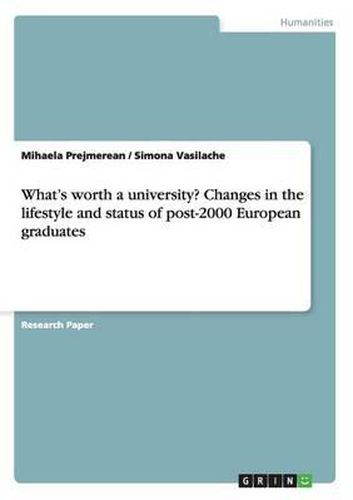Readings Newsletter
Become a Readings Member to make your shopping experience even easier.
Sign in or sign up for free!
You’re not far away from qualifying for FREE standard shipping within Australia
You’ve qualified for FREE standard shipping within Australia
The cart is loading…






Research Paper (postgraduate) from the year 2008 in the subject Sociology - Work, Profession, Education, Organisation, grade: keine, 47 entries in the bibliography, language: English, abstract: The paper is structured in two main parts: the first one comprises a literature review on the occurrences of lifestyle in literature, on samples of academic publications. The second one is dedicated to tracing the proposed concept of lifestyle calibration in a sub-sample of the European Social Survey, round 2, composed of young European graduates under 35. The H0 of the study states that the groups exhibiting a good lifestyle calibration are likely to reach high levels of life satisfaction, which is not valid for groups with wrongly calibrated lifestyles. The results of the research have shown the existence of two distinct population, in the sub-sample, which we referred to as pragmatic lifestyle and rhetoric lifestyle. The pragmatic lifestyle group has a good lifestyle calibration and, confirming H0, a high level of life satisfaction, which we recorded as a lifestyle estimator, while individuals falling into the second category have wrongly calibrated lifestyles and low levels of life satisfaction. These two groups are further divided into two other clusters, per lifestyle group: graduates with a pragmatic lifestyle can be either missionaries or skeptics, while graduates with a rhetoric lifestyle are either chameleons or misanthropes. This final systematizing of the groups, preparing the ground for a cross-national comparison between the various categories of graduates, resulted from multi-cluster analysis, probit regression and log-linear models employed on the data samples. The conclusions support the diversity of lifestyles in the population of young European graduates, which still allows for an operational systematizing. The lifestyle function resulting from the study enlarges and enriches the perspectives based exclusively on time allocation models, by introducing, in
$9.00 standard shipping within Australia
FREE standard shipping within Australia for orders over $100.00
Express & International shipping calculated at checkout
Research Paper (postgraduate) from the year 2008 in the subject Sociology - Work, Profession, Education, Organisation, grade: keine, 47 entries in the bibliography, language: English, abstract: The paper is structured in two main parts: the first one comprises a literature review on the occurrences of lifestyle in literature, on samples of academic publications. The second one is dedicated to tracing the proposed concept of lifestyle calibration in a sub-sample of the European Social Survey, round 2, composed of young European graduates under 35. The H0 of the study states that the groups exhibiting a good lifestyle calibration are likely to reach high levels of life satisfaction, which is not valid for groups with wrongly calibrated lifestyles. The results of the research have shown the existence of two distinct population, in the sub-sample, which we referred to as pragmatic lifestyle and rhetoric lifestyle. The pragmatic lifestyle group has a good lifestyle calibration and, confirming H0, a high level of life satisfaction, which we recorded as a lifestyle estimator, while individuals falling into the second category have wrongly calibrated lifestyles and low levels of life satisfaction. These two groups are further divided into two other clusters, per lifestyle group: graduates with a pragmatic lifestyle can be either missionaries or skeptics, while graduates with a rhetoric lifestyle are either chameleons or misanthropes. This final systematizing of the groups, preparing the ground for a cross-national comparison between the various categories of graduates, resulted from multi-cluster analysis, probit regression and log-linear models employed on the data samples. The conclusions support the diversity of lifestyles in the population of young European graduates, which still allows for an operational systematizing. The lifestyle function resulting from the study enlarges and enriches the perspectives based exclusively on time allocation models, by introducing, in